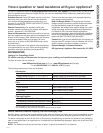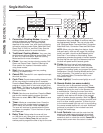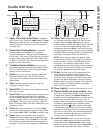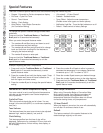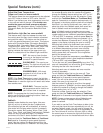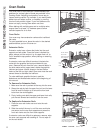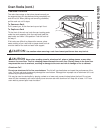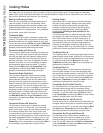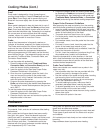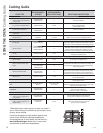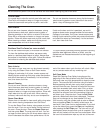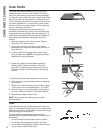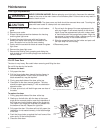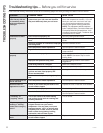
49-80668-2
15
Cookware
Proof
Proof mode is designed for rising (fermenting and
proofing) bread doughs. Press the Proof pad and then
press Start. Cover dough well to prevent drying out.
Bread will rise more rapidly than at room temperature.
Warm
Warm mode is designed to keep hot foods hot for up to 3
hours. To use this mode, press the Warm pad then press
Start. Cover foods that need to remain moist and do not
cover foods that should be crisp. Preheating is not required.
Do not use warm to heat cold food other than crisping
crackers, chips or dry cereal. It is also recommended that
food not be kept warm for more than 2 hours.
Probe
Internal food temperature is frequently used as an
indicator of doneness, especially for roasts and poultry.
The Probe mode monitors the internal food temperature
and turns the oven off when the internal food
temperature reaches the programmed temperature.
Minimum temperatures for food safety can be found at
www.IsItDoneYet.gov. The temperature probe can only
be used with Traditional Bake, Convection Bake, and
Convection Roast modes.
To use the probe with preheating:
1. Press the desired cook mode (Traditional Bake,
Convection Bake, or Convection Roast) pad and
enter the desired cooking temperature.
2. Insert the probe into the food (see Proper Probe
Placement Guidelines in this section).
3. Once the oven is preheated, place the food in the
oven and connect the probe to the probe outlet,
making sure it is fully inserted. Use caution, the oven
walls and probe outlet are hot.
4. Program the probe temperature by pressing the
Probe pad and entering the desired food temperature.
The maximum internal food temperature that you can
set is 200º F.
To use the probe without preheating:
1. Insert the probe into the food (see Proper Probe
Placement Guidelines in this section).
2. Place the food in the oven and connect the probe into
the probe outlet in the oven.
3. Program the desired probe and cooking mode settings
by pressing the Probe pad and entering the desired
food temperature, then pressing the cook mode pad
(Traditional Bake, Convection Bake, or Convection
Roast) and entering the desired cooking temperature.
Proper Probe Placement Guidelines
After preparing the meat and placing it on the cooking
pan follow these guidelines for proper probe placement.
Ŷ Insert the probe completely into the meat, up to the
handle, such that the point of the probe will rest in the
center of the thickest part of the meat.
Ŷ The probe should not touch bone, fat or gristle.
Ŷ For whole poultry insert the probe into the thickest
part of the breast.
Ŷ For boneless roasts, insert the probe into the center
of the roast.
Ŷ For bone-in ham or lamb, insert the probe into the
center of the lowest large muscle or joint.
Ŷ For casseroles or dishes such as meatloaf, insert the
probe into the center of the dish.
Ŷ For fish, insert the probe from just above the gill into
the meatiest area, parallel to the backbone.
Check the temperature at other locations in the food
with a food thermometer once the probe temperature
is reached to ensure that all portions of the food have
reached desired temperatures.
Probe Care Guidelines
Note: some double oven models have a probe in the
upper oven only.
Ŷ Use of probes other than the one provided with this
product may result in damage to the probe.
Ŷ Use the handles of the probe and plug when inserting
and removing them from the meat and outlet
Ŷ To avoid damaging your probe, do not use tongs to
pull on the cable when removing it.
Ŷ To avoid breaking the probe, make sure food is
completely defrosted before inserting the probe.
Ŷ To prevent possible burns, do not unplug the probe
from the outlet until the oven has cooled.
Ŷ Never leave the probe inside the oven during a self or
steam clean cycle.
Ŷ Do not store the probe in the oven.
Cookware Guidelines
The material, finish, and size of cookware affect baking
performance.
Dark, coated and dull pans absorb heat more readily
than light, shiny pans. Pans that absorb heat more
readily can result in a browner, crisper, and thicker crust.
If using dark and coated cookware check food earlier
than minimum cook time. If undesirable results are
obtained with this type of cookware consider reducing
oven temperature by 25º F next time.
Shiny pans can produce more evenly cooked baked
goods such as cakes and cookies.
Glass and ceramic pans heat slowly but retain heat well.
These types of pans work well for dishes such as pies
and custards.
Air insulated pans heat slowly and can reduce bottom
browning.
Keep cookware clean to promote even heating.
USING THE OVEN: Cooking Modes / Cookware
Cooking Modes (Cont.)



